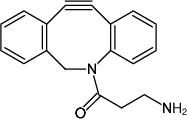Dibenzylcyclooctyne-Amine
| Cat. No. | Amount | Price (EUR) | Buy / Note |
|---|---|---|---|
| CLK-A103-25 | 25 mg | 199,40 | Add to Basket/Quote Add to Notepad |
| CLK-A103-100 | 100 mg | 514,00 | Add to Basket/Quote Add to Notepad |
| CLK-A103-1000 | 1 g | 3.136,30 | Add to Basket/Quote Add to Notepad |

For general laboratory use.
Shipping: shipped at ambient temperature
Storage Conditions: store at -20 °C
Shelf Life: 12 months after date of delivery
Molecular Formula: C18H16N2O
Molecular Weight: 276.33 g/mol
Exact Mass: 276.13 g/mol
CAS#: 1255942-06-3
Purity: ≥ 90 % (HPLC)
Form: solid
Color: slightly yellow to slightly orange
Solubility: DCM, DMF, DMSO, THF
Applications:
Protein-peptide conjugates
Peptide-small molecule conjugates
18F radiolabelling
Protein-oligonucleotide conjugates
Surface modification
Description:
Simple carbonyl/carboxyl reactive dibenzylcyclooctyne. Applicable for the modification of surfaces and particles with terminal acids, active esters and aldehydes and for the introduction of dibenzylcyclooctyne into organic/inorganic compounds.
Important Product Information
Do not use DTT, TCEP or β-mercaptoethanol, because they will reduce the azide.
Copper-free Click Reaction
Troubleshooting
Problem: Low conjugation of DBCO and azide
BIOZ Product Citations:
Selected References:
Kuppevelt et al. (2017) Sequencing of glycosaminoglycans with potential to interrogate sequence-specific interactions. Scientific Reports 7:14785.
Simon et al. (2012) Facile Double-Functionalization of Designed Ankyrin Repeat Proteins using Click and Thiol Chemistries. Bioconjugate Chem. 23 (2):279.
Zeng et al. (2012). 64Cu Core-Labeled Nanoparticles with High Specific Activity via Metal-Free Click Chemistry. ACS Nano. 6 (6):5209.
Arumugam et al. (2011). [18F]Azadibenzocyclooctyne ([18F]ADIBO): A biocompatible radioactive labeling synthon for peptides using catalyst free [3+2] cycloaddition. Bioorg. Med. Chem. Lett. 21:6987.
Campbell-Verduyn et al. (2011). Strain-Promoted Copper-Free Click Chemistry for 18F Radiolabeling of Bombesin. Angew. Chem. Int. Ed. 50:11117.
Debets et al. (2010) Aza-dibenzocyclooctynes for fast and efficient enzyme PEGylation via copper-free (3+2) cycloaddition. Chem. Commun. 46:97.